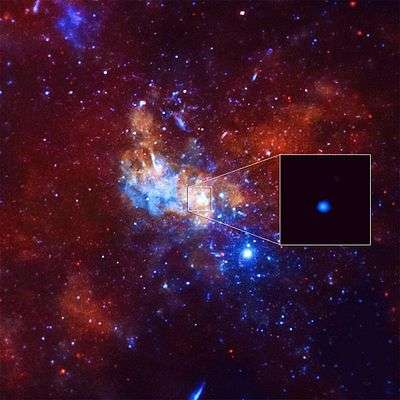Supermassive black hole
A supermassive black hole (SMBH or sometimes SBH) is the largest type of black hole, containing a mass of the order of hundreds of thousands to billions of times the mass of the Sun (M☉). Black holes are a class of astronomical object that have undergone gravitational collapse, leaving behind spheroidal regions of space from which nothing can escape, not even light. Observational evidence indicates that nearly all large galaxies contain a supermassive black hole, located at the galaxy's center.[3][4] In the case of the Milky Way, the supermassive black hole corresponds to the location of Sagittarius A* at the Galactic Core.[5][6] Accretion of interstellar gas onto supermassive black holes is the process responsible for powering quasars and other types of active galactic nuclei.

Description
Supermassive black holes have properties that distinguish them from lower-mass classifications. First, the average density of a SMBH (defined as the mass of the black hole divided by the volume within its Schwarzschild radius) can be less than the density of water in the case of some SMBHs.[7] This is because the Schwarzschild radius is directly proportional to its mass. Since the volume of a spherical object (such as the event horizon of a non-rotating black hole) is directly proportional to the cube of the radius, the density of a black hole is inversely proportional to the square of the mass, and thus higher mass black holes have lower average density.[8] In addition, the tidal forces in the vicinity of the event horizon are significantly weaker for supermassive black holes. The tidal force on a body at the event horizon is likewise inversely proportional to the square of the mass:[9] a person on the surface of the Earth and one at the event horizon of a 10 million M☉ black hole experience about the same tidal force between their head and feet. Unlike with stellar mass black holes, one would not experience significant tidal force until very deep into the black hole.[10]
Some astronomers have begun labeling black holes of at least 10 billion M☉ as ultramassive black holes.[11][12] Most of these (such as TON 618) are associated with exceptionally energetic quasars.
History of research
The story of how supermassive black holes were found began with the investigation by Maarten Schmidt of the radio source 3C 273 in 1963. Initially this was thought to be a star, but the spectrum proved puzzling. It was determined to be hydrogen emission lines that had been red shifted, indicating the object was moving away from the Earth.[13] Hubble's law showed that the object was located several billion light-years away, and thus must be emitting the energy equivalent of hundreds of galaxies. The rate of light variations of the source, dubbed a quasi-stellar object, or quasar, suggested the emitting region had a diameter of one parsec or less. Four such sources had been identified by 1964.[14]
In 1963, Fred Hoyle and W. A. Fowler proposed the existence of hydrogen burning supermassive stars (SMS) as an explanation for the compact dimensions and high energy output of quasars. These would have a mass of about 105 – 109 M☉. However, Richard Feynman noted stars above a certain critical mass are dynamically unstable and would collapse into a black hole, at least if they were non-rotating.[15] Fowler then proposed that these supermassive stars would undergo a series of collapse and explosion oscillations, thereby explaining the energy output pattern. Appenzeller and Fricke (1972) built models of this behavior, but found that the resulting star would still undergo collapse, concluding that a non-rotating 0.75×106 M☉ SMS "cannot escape collapse to a black hole by burning its hydrogen through the CNO cycle".[16]
Edwin E. Salpeter and Yakov B. Zel'dovich made the proposal in 1964 that matter falling onto a massive compact object would explain the properties of quasars. It would require a mass of around 108 M☉ to match the output of these objects. Donald Lynden-Bell noted in 1969 that the infalling gas would form a flat disk that spirals into the central "Schwarzschild throat". He noted that the relatively low output of nearby galactic cores implied these were old, inactive quasars.[17] Meanwhile, in 1967, Martin Ryle and Malcolm Longair suggested that nearly all sources of extra-galactic radio emission could be explained by a model in which particles are ejected from galaxies at relativistic velocities; meaning they are moving near the speed of light.[18] Martin Ryle, Malcolm Longair, and Peter Scheuer then proposed in 1973 that the compact central nucleus could be the original energy source for these relativistic jets.[17]
Arthur M. Wolfe and Geoffrey Burbidge noted in 1970 that the large velocity dispersion of the stars in the nuclear region of elliptical galaxies could only be explained by a large mass concentration at the nucleus; larger than could be explained by ordinary stars. They showed that the behavior could be explained by a massive black hole with up to 1010 M☉, or a large number of smaller black holes with masses below 103 M☉.[19] Dynamical evidence for a massive dark object was found at the core of the active elliptical galaxy Messier 87 in 1978, initially estimated at 5×109 M☉.[20] Discovery of similar behavior in other galaxies soon followed, including the Andromeda Galaxy in 1984 and the Sombrero Galaxy in 1988.[3]
Donald Lynden-Bell and Martin Rees hypothesized in 1971 that the center of the Milky Way galaxy would contain a massive black hole.[21] Sagittarius A* was discovered and named on February 13 and 15, 1974, by astronomers Bruce Balick and Robert Brown using the Green Bank Interferometer of the National Radio Astronomy Observatory.[22] They discovered a radio source that emits synchrotron radiation; it was found to be dense and immobile because of its gravitation. This was, therefore, the first indication that a supermassive black hole exists in the center of the Milky Way.
The Hubble Space Telescope, launched in 1990, provided the resolution needed to perform more refined observations of galactic nuclei. In 1994 the Faint Object Spectrograph on the Hubble was used to observe Messier 87, finding that ionized gas was orbiting the central part of the nucleus at a velocity of ±500 km/s. The data indicated a concentrated mass of (2.4±0.7)×109 M☉ lay within a 0.25″ span, providing strong evidence of a supermassive black hole.[23] Using the Very Long Baseline Array to observe Messier 106, Miyoshi et al. (1995) were able to demonstrate that the emission from an H2O maser in this galaxy came from a gaseous disk in the nucleus that orbited a concentrated mass of 3.6×107 M☉, which was constrained to a radius of 0.13 parsecs. They noted that a swarm of solar mass black holes within a radius this small would not survive for long without undergoing collisions, making a supermassive black hole the sole viable candidate.[24]
On April 10, 2019, the Event Horizon Telescope project released the first image of a black hole, in the center of the galaxy Messier 87.[2]
In February 2020, astronomers reported that a cavity in the Ophiuchus Supercluster, originating from a supermassive black hole, is a result of the largest known explosion in the Universe since the Big Bang.[25][26][27]
In March 2020, astronomers proposed a way of better seeing more of the rings in the first black hole image.[28][29]
Formation
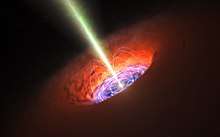
The origin of supermassive black holes remains an open field of research. Astrophysicists agree that once a black hole is in place in the center of a galaxy, it can grow by accretion of matter and by merging with other black holes. There are, however, several hypotheses for the formation mechanisms and initial masses of the progenitors, or "seeds", of supermassive black holes.
One hypothesis is that the seeds are black holes of tens or perhaps hundreds of solar masses that are left behind by the explosions of massive stars and grow by accretion of matter. Another model hypothesizes that before the first stars, large gas clouds could collapse into a "quasi-star", which would in turn collapse into a black hole of around 20 M☉.[30] These stars may have also been formed by dark matter halos drawing in enormous amounts of gas by gravity, which would then produce supermassive stars with tens of thousands of solar masses.[31][32] The "quasi-star" becomes unstable to radial perturbations because of electron-positron pair production in its core and could collapse directly into a black hole without a supernova explosion (which would eject most of its mass, preventing the black hole from growing as fast). Given sufficient mass nearby, the black hole could accrete to become an intermediate-mass black hole and possibly a SMBH if the accretion rate persists.[30]

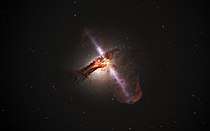
Another model involves a dense stellar cluster undergoing core-collapse as the negative heat capacity of the system drives the velocity dispersion in the core to relativistic speeds.[35] Finally, primordial black holes could have been produced directly from external pressure in the first moments after the Big Bang. These primordial black holes would then have more time than any of the above models to accrete, allowing them sufficient time to reach supermassive sizes. Formation of black holes from the deaths of the first stars has been extensively studied and corroborated by observations. The other models for black hole formation listed above are theoretical.
The difficulty in forming a supermassive black hole resides in the need for enough matter to be in a small enough volume. This matter needs to have very little angular momentum in order for this to happen. Normally, the process of accretion involves transporting a large initial endowment of angular momentum outwards, and this appears to be the limiting factor in black hole growth. This is a major component of the theory of accretion disks. Gas accretion is the most efficient and also the most conspicuous way in which black holes grow. The majority of the mass growth of supermassive black holes is thought to occur through episodes of rapid gas accretion, which are observable as active galactic nuclei or quasars. Observations reveal that quasars were much more frequent when the Universe was younger, indicating that supermassive black holes formed and grew early. A major constraining factor for theories of supermassive black hole formation is the observation of distant luminous quasars, which indicate that supermassive black holes of billions of solar masses had already formed when the Universe was less than one billion years old. This suggests that supermassive black holes arose very early in the Universe, inside the first massive galaxies.

A vacancy exists in the observed mass distribution of black holes. Black holes that spawn from dying stars have masses 5–80 M☉. The minimal supermassive black hole is approximately a hundred thousand solar masses. Mass scales between these ranges are dubbed intermediate-mass black holes. Such a gap suggests a different formation process. However, some models[37] suggest that ultraluminous X-ray sources (ULXs) may be black holes from this missing group.
There is, however, an upper limit to how large supermassive black holes can grow. So-called ultramassive black holes (UMBHs), which are at least ten times the size of most supermassive black holes, at 10 billion solar masses or more, appear to have a theoretical upper limit of around 50 billion solar masses, as anything above this slows growth down to a crawl (the slowdown tends to start around 10 billion solar masses) and causes the unstable accretion disk surrounding the black hole to coalesce into stars that orbit it.[38][39][40][41]
A small minority of sources argue that distant supermassive black holes whose large size is hard to explain so soon after the Big Bang, such as ULAS J1342+0928,[42] may be evidence that our universe is the result of a Big Bounce, instead of a Big Bang, with these supermassive black holes being formed before the Big Bounce.[43][44]
Activity and galactic evolution
Gravitation from supermassive black holes in the center of many galaxies is thought to power active objects such as Seyfert galaxies and quasars. An active galactic nucleus (AGN) is now considered to be a galactic core hosting a massive black hole that is accreting matter and displays a sufficiently strong luminosity. The nuclear region of the Milky Way, for example, lacks sufficient luminosity to satisfy this condition. The unified model of AGN is the concept that the large range of observed properties of the AGN taxonomy can be explained using just a small number of physical parameters. For the initial model, these values consisted of the angle of the accretion disk's torus to the line of sight and the luminosity of the source. AGN can be divided into two main groups: a radiative mode AGN in which most of the output is in the form of electromagnetic radiation through an optically thick accretion disk, and a jet mode in which relativistic jets emerge perpendicular to the disk.[45]
An empirical correlation between the size of supermassive black holes and the stellar velocity dispersion of a galaxy bulge[46] is called the M-sigma relation.
Evidence
Doppler measurements

Some of the best evidence for the presence of black holes is provided by the Doppler effect whereby light from nearby orbiting matter is red-shifted when receding and blue-shifted when advancing. For matter very close to a black hole the orbital speed must be comparable with the speed of light, so receding matter will appear very faint compared with advancing matter, which means that systems with intrinsically symmetric discs and rings will acquire a highly asymmetric visual appearance. This effect has been allowed for in modern computer generated images such as the example presented here, based on a plausible model[47] for the supermassive black hole in Sgr A* at the centre of our own galaxy. However the resolution provided by presently available telescope technology is still insufficient to confirm such predictions directly.
What already has been observed directly in many systems are the lower non-relativistic velocities of matter orbiting further out from what are presumed to be black holes. Direct Doppler measures of water masers surrounding the nuclei of nearby galaxies have revealed a very fast Keplerian motion, only possible with a high concentration of matter in the center. Currently, the only known objects that can pack enough matter in such a small space are black holes, or things that will evolve into black holes within astrophysically short timescales. For active galaxies farther away, the width of broad spectral lines can be used to probe the gas orbiting near the event horizon. The technique of reverberation mapping uses variability of these lines to measure the mass and perhaps the spin of the black hole that powers active galaxies.
In the Milky Way
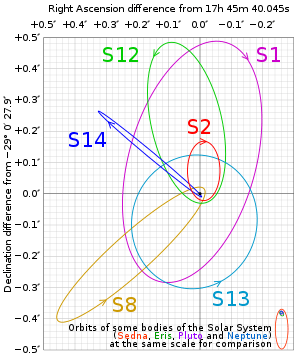
Astronomers are confident that the Milky Way galaxy has a supermassive black hole at its center, 26,000 light-years from the Solar System, in a region called Sagittarius A*[49] because:
- The star S2 follows an elliptical orbit with a period of 15.2 years and a pericenter (closest distance) of 17 light-hours (1.8×1013 m or 120 AU) from the center of the central object.[50]
- From the motion of star S2, the object's mass can be estimated as 4.1 million M☉,[51][52] or about 8.2×1036 kg.
- The radius of the central object must be less than 17 light-hours, because otherwise S2 would collide with it. Observations of the star S14[53] indicate that the radius is no more than 6.25 light-hours, about the diameter of Uranus' orbit.
- No known astronomical object other than a black hole can contain 4.1 million M☉ in this volume of space.
Infrared observations of bright flare activity near Sagittarius A* show orbital motion of plasma with a period of 45±15 min at a separation of six to ten times the gravitational radius of the candidate SMBH. This emission is consistent with a circularized orbit of a polarized "hot spot" on an accretion disk in a strong magnetic field. The radiating matter is orbiting at 30% of the speed of light just outside the innermost stable circular orbit.[54]
On January 5, 2015, NASA reported observing an X-ray flare 400 times brighter than usual, a record-breaker, from Sagittarius A*. The unusual event may have been caused by the breaking apart of an asteroid falling into the black hole or by the entanglement of magnetic field lines within gas flowing into Sagittarius A*, according to astronomers.[55]
Outside the Milky Way
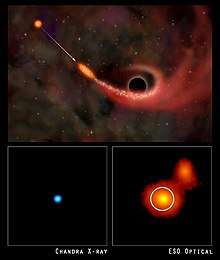
Unambiguous dynamical evidence for supermassive black holes exists only in a handful of galaxies;[57] these include the Milky Way, the Local Group galaxies M31 and M32, and a few galaxies beyond the Local Group, e.g. NGC 4395. In these galaxies, the mean square (or rms) velocities of the stars or gas rises proportionally to 1/r near the center, indicating a central point mass. In all other galaxies observed to date, the rms velocities are flat, or even falling, toward the center, making it impossible to state with certainty that a supermassive black hole is present.[57] Nevertheless, it is commonly accepted that the center of nearly every galaxy contains a supermassive black hole.[58] The reason for this assumption is the M-sigma relation, a tight (low scatter) relation between the mass of the hole in the 10 or so galaxies with secure detections, and the velocity dispersion of the stars in the bulges of those galaxies.[59] This correlation, although based on just a handful of galaxies, suggests to many astronomers a strong connection between the formation of the black hole and the galaxy itself.[58]
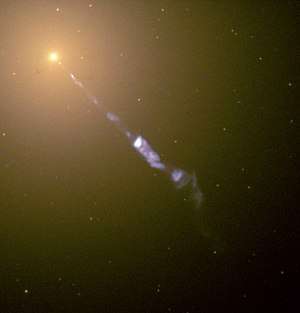
The nearby Andromeda Galaxy, 2.5 million light-years away, contains a (1.1–2.3)×108 (110–230 million) M☉ central black hole, significantly larger than the Milky Way's.[60] The largest supermassive black hole in the Milky Way's vicinity appears to be that of M87, at a mass of (6.4±0.5)×109 (c. 6.4 billion) M☉ at a distance of 53.5 million light-years.[61][62] The supergiant elliptical galaxy NGC 4889, at a distance of 336 million light-years away in the Coma Berenices constellation, contains a black hole measured to be 2.1×1010 (21 billion) M☉.[63]
Masses of black holes in quasars can be estimated via indirect methods that are subject to substantial uncertainty. The quasar TON 618 is an example of an object with an extremely large black hole, estimated at 6.6×1010 (66 billion) M☉.[64] Its redshift is 2.219. Other examples of quasars with large estimated black hole masses are the hyperluminous quasar APM 08279+5255, with an estimated mass of 2.3×1010 (23 billion) M☉, and the quasar S5 0014+81, with a mass of 4.0×1010 (40 billion) M☉, or 10,000 times the mass of the black hole at the Milky Way Galactic Center.
Some galaxies, such as the galaxy 4C +37.11, appear to have two supermassive black holes at their centers, forming a binary system. If they collided, the event would create strong gravitational waves.[65] Binary supermassive black holes are believed to be a common consequence of galactic mergers.[66] The binary pair in OJ 287, 3.5 billion light-years away, contains the most massive black hole in a pair, with a mass estimated at 18 billion M☉.[67] In 2011, a super-massive black hole was discovered in the dwarf galaxy Henize 2-10, which has no bulge. The precise implications for this discovery on black hole formation are unknown, but may indicate that black holes formed before bulges.[68]
On March 28, 2011, a supermassive black hole was seen tearing a mid-size star apart.[69] That is the only likely explanation of the observations that day of sudden X-ray radiation and the follow-up broad-band observations.[70][71] The source was previously an inactive galactic nucleus, and from study of the outburst the galactic nucleus is estimated to be a SMBH with mass of the order of a million solar masses. This rare event is assumed to be a relativistic outflow (material being emitted in a jet at a significant fraction of the speed of light) from a star tidally disrupted by the SMBH. A significant fraction of a solar mass of material is expected to have accreted onto the SMBH. Subsequent long-term observation will allow this assumption to be confirmed if the emission from the jet decays at the expected rate for mass accretion onto a SMBH.
In 2012, astronomers reported an unusually large mass of approximately 17 billion M☉ for the black hole in the compact, lenticular galaxy NGC 1277, which lies 220 million light-years away in the constellation Perseus. The putative black hole has approximately 59 percent of the mass of the bulge of this lenticular galaxy (14 percent of the total stellar mass of the galaxy).[72] Another study reached a very different conclusion: this black hole is not particularly overmassive, estimated at between 2 and 5 billion M☉ with 5 billion M☉ being the most likely value.[73] On February 28, 2013 astronomers reported on the use of the NuSTAR satellite to accurately measure the spin of a supermassive black hole for the first time, in NGC 1365, reporting that the event horizon was spinning at almost the speed of light.[74][75]
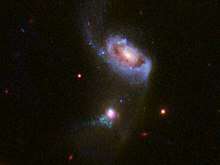
In September 2014, data from different X-ray telescopes has shown that the extremely small, dense, ultracompact dwarf galaxy M60-UCD1 hosts a 20 million solar mass black hole at its center, accounting for more than 10% of the total mass of the galaxy. The discovery is quite surprising, since the black hole is five times more massive than the Milky Way's black hole despite the galaxy being less than five-thousandths the mass of the Milky Way.
Some galaxies, however, lack any supermassive black holes in their centers. Although most galaxies with no supermassive black holes are very small, dwarf galaxies, one discovery remains mysterious: The supergiant elliptical cD galaxy A2261-BCG has not been found to contain an active supermassive black hole, despite the galaxy being one of the largest galaxies known; ten times the size and one thousand times the mass of the Milky Way. Since a supermassive black hole will only be visible while it is accreting, a supermassive black hole can be nearly invisible, except in its effects on stellar orbits.
In December 2017, astronomers reported the detection of the most distant quasar currently known, ULAS J1342+0928, containing the most distant supermassive black hole, at a reported redshift of z = 7.54, surpassing the redshift of 7 for the previously known most distant quasar ULAS J1120+0641.[77][78][79]
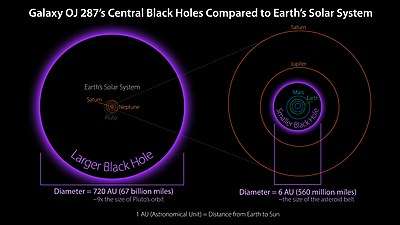
(1:22; animation; 28 April 2020)
Hawking radiation
Hawking radiation is black-body radiation that is predicted to be released by black holes, due to quantum effects near the event horizon. This radiation reduces the mass and energy of black holes, causing them to shrink and ultimately vanish. If black holes evaporate via Hawking radiation, a supermassive black hole with a mass of 1011 (100 billion) M☉ will evaporate in around 2×10100 years.[80] Some monster black holes in the universe are predicted to continue to grow up to perhaps 1014 M☉ during the collapse of superclusters of galaxies. Even these would evaporate over a timescale of up to 10106 years.[81]
See also
- Black holes in fiction
- Central massive object
- Galactic Center – Rotational center of the Milky Way galaxy
- Galactic Center GeV Excess – Unexplained gamma-ray radiation in center of Milky Way galaxy
- General relativity – Einstein's theory of gravitation as curved spacetime
- Hypercompact stellar system
- List of most massive black holes – Wikipedia list article
- Spin-flip – A sudden change of spin axis caused by merging with another black hole
References
- Overbye, Dennis (April 10, 2019). "Black Hole Picture Revealed for the First Time - Astronomers at last have captured an image of the darkest entities in the cosmos - Comments". The New York Times. Retrieved April 10, 2019.
- The Event Horizon Telescope Collaboration (April 10, 2019). "First M87 Event Horizon Telescope Results. I. The Shadow of the Supermassive Black Hole". The Astrophysical Journal Letters. 875 (1): L1. Bibcode:2019ApJ...875L...1E. doi:10.3847/2041-8213/ab0ec7.
- Kormendy, John; Richstone, Douglas (1995), "Inward Bound—The Search For Supermassive Black Holes In Galactic Nuclei", Annual Review of Astronomy and Astrophysics, 33: 581, Bibcode:1995ARA&A..33..581K, doi:10.1146/annurev.aa.33.090195.003053
- Kormendy, John; Ho, Luis (2013). "Coevolution (Or Not) of Supermassive Black Holes and Host Galaxies". Annual Review of Astronomy and Astrophysics. 51 (1): 511–653. arXiv:1304.7762. Bibcode:2013ARA&A..51..511K. doi:10.1146/annurev-astro-082708-101811.
- Ghez, A.; Klein, B.; Morris, M.; Becklin, E (1998). "High Proper-Motion Stars in the Vicinity of Sagittarius A*: Evidence for a Supermassive Black Hole at the Center of Our Galaxy". The Astrophysical Journal. 509 (2): 678–686. arXiv:astro-ph/9807210. Bibcode:1998ApJ...509..678G. doi:10.1086/306528.
- Schödel, R.; et al. (2002). "A star in a 15.2-year orbit around the supermassive black hole at the centre of the Milky Way". Nature. 419 (6908): 694–696. arXiv:astro-ph/0210426. Bibcode:2002Natur.419..694S. doi:10.1038/nature01121. PMID 12384690.
- Celotti, A.; Miller, J.C.; Sciama, D.W. (1999). "Astrophysical evidence for the existence of black holes". Class. Quantum Grav. (Submitted manuscript). 16 (12A): A3–A21. arXiv:astro-ph/9912186. Bibcode:1999CQGra..16A...3C. doi:10.1088/0264-9381/16/12A/301.CS1 maint: ref=harv (link)
- Ehsan, Baaquie Belal; Hans, Willeboordse Frederick (2015), Exploring The Invisible Universe: From Black Holes To Superstrings, World Scientific, p. 200, Bibcode:2015eiub.book.....B, ISBN 978-9814618694
- Kutner, Marc L. (2003), Astronomy: A Physical Perspective, Cambridge University Press, p. 149, ISBN 978-0521529273
- "Problem 138: The Intense Gravity of a Black Hole", Space Math @ NASA: Mathematics Problems about Black Holes, NASA, retrieved December 4, 2018
- Irving, Michael (February 21, 2018). ""Ultramassive" black holes may be the biggest ever found – and they're growing fast". News Atlas. GIZMAG PTY LTD.
- From Super to Ultra: Just How Big Can Black Holes Get? | NASA
- Schmidt, Maarten (1965), "3C 273: A Star-like Object with Large Red-Shift", in Robinson, Ivor; Schild, Alfred; Schucking, E.L. (eds.), Quasi-Stellar Sources and Gravitational Collapse, Proceedings of the 1st Texas Symposium on Relativistic Astrophysics, Chicago: University of Chicago Press, p. 455, Bibcode:1965qssg.conf..455S
- Greenstein, Jesse L.; Schmidt, Maarten (July 1964), "The Quasi-Stellar Radio Sources 3C 48 and 3C 273", Astrophysical Journal, 140: 1, Bibcode:1964ApJ...140....1G, doi:10.1086/147889.
- Feynman, Richard (2018), Feynman Lectures On Gravitation, CRC Press, p. 12, ISBN 978-0429982484
- Appenzeller, I.; Fricke, K. (April 1972), "Hydrodynamic Model Calculations for Supermassive Stars I. The Collapse of a Nonrotating 0.75×106 M☉ Star", Astronomy and Astrophysics, 18: 10, Bibcode:1972A&A....18...10A
- Lang, Kenneth R. (2013), Astrophysical Formulae: Space, Time, Matter and Cosmology, Astronomy and Astrophysics Library (3 ed.), Springer, p. 217, ISBN 978-3662216392
- Ryle, Martin, Sir; Longair, M. S. (1967), "A possible method for investigating the evolution of radio galaxies", Monthly Notices of the Royal Astronomical Society, 136 (2): 123, Bibcode:1967MNRAS.136..123R, doi:10.1093/mnras/136.2.123
- Wolfe, A. M.; Burbidge, G. R. (August 1970). "Black Holes in Elliptical Galaxies". Astrophysical Journal. 161: 419. Bibcode:1970ApJ...161..419W. doi:10.1086/150549.
- Sargent, W. L. W.; et al. (May 1, 1978). "Dynamical evidence for a central mass concentration in the galaxy M87". Astrophysical Journal, Part 1. 221: 731–744. Bibcode:1978ApJ...221..731S. doi:10.1086/156077.
- Schödel, R.; Genzel, R. (2006), Alfaro, Emilio Javier; Perez, Enrique; Franco, José (eds.), How does the Galaxy work?: A Galactic Tertulia with Don Cox and Ron Reynolds, Astrophysics and Space Science Library, 315, Springer Science & Business Media, p. 201, ISBN 978-1402026201
- Melia 2007, p. 2.
- Harms, Richard J.; et al. (November 1994), "HST FOS spectroscopy of M87: Evidence for a disk of ionized gas around a massive black hole", Astrophysical Journal, Part 2, 435 (1): L35–L38, Bibcode:1994ApJ...435L..35H, doi:10.1086/187588
- Miyoshi, Makoto; et al. (January 1995). "Evidence for a black hole from high rotation velocities in a sub-parsec region of NGC4258". Nature. 373 (6510): 127–129. Bibcode:1995Natur.373..127M. doi:10.1038/373127a0.
- Overbye, Dennis (March 6, 2020). "This Black Hole Blew a Hole in the Cosmos - The galaxy cluster Ophiuchus was doing just fine until WISEA J171227.81-232210.7 — a black hole several billion times as massive as our sun — burped on it". The New York Times. Retrieved March 6, 2020.
- "Biggest cosmic explosion ever detected left huge dent in space". The Guardian. February 27, 2020. Retrieved March 6, 2020.
- "Astronomers detect biggest explosion in the history of the Universe". Science Daily. February 27, 2020. Retrieved March 6, 2020.
- Overbye, Dennis (March 28, 2020). "Infinite Visions Were Hiding in the First Black Hole Image's Rings - Scientists proposed a technique that would allow us to see more of the unseeable". The New York Times. Retrieved March 29, 2020.
- Johnson, Michael D.; et al. (March 18, 2020). "Universal interferometric signatures of a black hole's photon ring". Science Advances. 6 (12, eaaz1310): eaaz1310. doi:10.1126/sciadv.aaz1310. Retrieved March 29, 2020.
- Begelman, M. C.; et al. (June 2006). "Formation of supermassive black holes by direct collapse in pre-galactic haloed". Monthly Notices of the Royal Astronomical Society. 370 (1): 289–298. arXiv:astro-ph/0602363. Bibcode:2006MNRAS.370..289B. doi:10.1111/j.1365-2966.2006.10467.x.
- Yasemin Saplakoglu (September 29, 2017). "Zeroing In on How Supermassive Black Holes Formed". Scientific American. Retrieved April 8, 2019.
- Mara Johnson-Goh (November 20, 2017). "Cooking up supermassive black holes in the early universe". Astronomy. Retrieved April 8, 2019.
- "Biggest Black Hole Blast Discovered". ESO Press Release. Retrieved November 28, 2012.
- "Artist's illustration of galaxy with jets from a supermassive black hole". Hubble Space Telescope. Retrieved November 27, 2018.
- Spitzer, L. (1987). Dynamical Evolution of Globular Clusters. Princeton University Press. ISBN 978-0-691-08309-4.
- "Stars Born in Winds from Supermassive Black Holes – ESO's VLT spots brand-new type of star formation". www.eso.org. Retrieved March 27, 2017.
- Winter, L.M.; et al. (October 2006). "XMM-Newton Archival Study of the ULX Population in Nearby Galaxies". Astrophysical Journal. 649 (2): 730–752. arXiv:astro-ph/0512480. Bibcode:2006ApJ...649..730W. doi:10.1086/506579.
- King, Andrew (February 2016). "How big can a black hole grow?". Monthly Notices of the Royal Astronomical Society: Letters. 456 (1): L109–L112. arXiv:1511.08502. Bibcode:2016MNRAS.456L.109K. doi:10.1093/mnrasl/slv186.
- Trosper, Jaime (May 5, 2014). "Is There a Limit to How Large Black Holes Can Become?". futurism.com. Retrieved November 27, 2018.
- Clery, Daniel (December 21, 2015). "Limit to how big black holes can grow is astonishing". sciencemag.org. Retrieved November 27, 2018.
- ap507. "Black holes could grow as large as 50 billion suns before their food crumbles into stars, research shows — University of Leicester". www2.le.ac.uk. Retrieved November 27, 2018.
- Landau, Elizabeth; Bañados, Eduardo (December 6, 2017). "Found: Most Distant Black Hole". NASA. Retrieved December 6, 2017.
"This black hole grew far larger than we expected in only 690 million years after the Big Bang, which challenges our theories about how black holes form," said study co-author Daniel Stern of NASA's Jet Propulsion Laboratory in Pasadena, California.
- Jamie Seidel (December 7, 2017). "Black hole at the dawn of time challenges our understanding of how the universe was formed". News Corp Australia. Retrieved December 9, 2017.
It had reached its size just 690 million years after the point beyond which there is nothing. The most dominant scientific theory of recent years describes that point as the Big Bang—a spontaneous eruption of reality as we know it out of a quantum singularity. But another idea has recently been gaining weight: that the universe goes through periodic expansions and contractions—resulting in a 'Big Bounce'. And the existence of early black holes has been predicted to be a key telltale as to whether or not the idea may be valid. This one is very big. To get to its size—800 million times more mass than our Sun—it must have swallowed a lot of stuff. ... As far as we understand it, the universe simply wasn't old enough at that time to generate such a monster.
- Youmagazine staff (December 8, 2017). "A Black Hole that is more ancient than the Universe" (in Greek). You Magazine (Greece). Retrieved December 9, 2017.
This new theory that accepts that the Universe is going through periodic expansions and contractions is called "Big Bounce"
- Netzer, Hagai (August 2015). "Revisiting the Unified Model of Active Galactic Nuclei". Annual Review of Astronomy and Astrophysics. 53: 365–408. arXiv:1505.00811. Bibcode:2015ARA&A..53..365N. doi:10.1146/annurev-astro-082214-122302.
- Gultekin K; et al. (2009). "The M and M-L Relations in Galactic Bulges, and Determinations of Their Intrinsic Scatter". The Astrophysical Journal. 698 (1): 198–221. arXiv:0903.4897. Bibcode:2009ApJ...698..198G. doi:10.1088/0004-637X/698/1/198.
- Straub, O.; Vincent, F.H.; Abramowicz, M.A.; Gourgoulhon, E.; Paumard, T. (2012). "Modelling the black hole silhouette in Sgr A* with ion tori". Astron. Astrophys. 543: A83. doi:10.1051/0004-6361/201219209.
- Eisenhauer; et al. (2005). "SINFONI in the Galactic Center: Young Stars and Infrared Flares in the Central Light-Month". The Astrophysical Journal. 628 (1): 246–259. arXiv:astro-ph/0502129. Bibcode:2005ApJ...628..246E. doi:10.1086/430667.
- Henderson, Mark (December 9, 2008). "Astronomers confirm black hole at the heart of the Milky Way". London: Times Online. Retrieved May 17, 2009.
- Schödel, R.; et al. (October 17, 2002). "A star in a 15.2-year orbit around the supermassive black hole at the centre of the Milky Way". Nature. 419 (6908): 694–696. arXiv:astro-ph/0210426. Bibcode:2002Natur.419..694S. doi:10.1038/nature01121. PMID 12384690.
- Ghez, A. M.; et al. (December 2008). "Measuring Distance and Properties of the Milky Way's Central Supermassive Black Hole with Stellar Orbits". Astrophysical Journal. 689 (2): 1044–1062. arXiv:0808.2870. Bibcode:2008ApJ...689.1044G. doi:10.1086/592738.
- "Milky Way's Central Monster Measured - Sky & Telescope". skyandtelescope.com. August 28, 2008.
- Ghez, A. M.; Salim, S.; Hornstein, S. D.; Tanner, A.; Lu, J. R.; Morris, M.; Becklin, E. E.; Duchêne, G. (May 2005). "Stellar Orbits around the Galactic Center Black Hole". The Astrophysical Journal. 620 (2): 744–757. arXiv:astro-ph/0306130. Bibcode:2005ApJ...620..744G. doi:10.1086/427175.
- Gravity Collaboration; et al. (October 2018). "Detection of orbital motions near the last stable circular orbit of the massive black hole SgrA*". Astronomy & Astrophysics. 618: 15. arXiv:1810.12641. Bibcode:2018A&A...618L..10G. doi:10.1051/0004-6361/201834294. L10.
- Chou, Felicia; Anderson, Janet; Watzke, Megan (January 5, 2015). "Release 15-001 – NASA's Chandra Detects Record-Breaking Outburst from Milky Way's Black Hole". NASA. Retrieved January 6, 2015.
- "Chandra :: Photo Album :: RX J1242-11 :: 18 Feb 04". chandra.harvard.edu.
- Merritt, David (2013). Dynamics and Evolution of Galactic Nuclei. Princeton, NJ: Princeton University Press. p. 23. ISBN 9780691158600.
- King, Andrew (September 15, 2003). "Black Holes, Galaxy Formation, and the MBH-σ Relation". The Astrophysical Journal Letters. 596 (1): L27–L29. arXiv:astro-ph/0308342. Bibcode:2003ApJ...596L..27K. doi:10.1086/379143.
- Ferrarese, Laura; Merritt, David (August 10, 2000). "A Fundamental Relation between Supermassive Black Holes and Their Host Galaxies". The Astrophysical Journal. 539 (1): L9–12. arXiv:astro-ph/0006053. Bibcode:2000ApJ...539L...9F. doi:10.1086/312838.
- Bender, Ralf; et al. (September 20, 2005). "HST STIS Spectroscopy of the Triple Nucleus of M31: Two Nested Disks in Keplerian Rotation around a Supermassive Black Hole". The Astrophysical Journal. 631 (1): 280–300. arXiv:astro-ph/0509839. Bibcode:2005ApJ...631..280B. doi:10.1086/432434.
- Gebhardt, Karl; Thomas, Jens (August 2009). "The Black Hole Mass, Stellar Mass-to-Light Ratio, and Dark Halo in M87". The Astrophysical Journal. 700 (2): 1690–1701. arXiv:0906.1492. Bibcode:2009ApJ...700.1690G. doi:10.1088/0004-637X/700/2/1690.
- Macchetto, F.; Marconi, A.; Axon, D. J.; Capetti, A.; Sparks, W.; Crane, P. (November 1997). "The Supermassive Black Hole of M87 and the Kinematics of Its Associated Gaseous Disk". Astrophysical Journal. 489 (2): 579. arXiv:astro-ph/9706252. Bibcode:1997ApJ...489..579M. doi:10.1086/304823.
- Overbye, Dennis (December 5, 2011). "Astronomers Find Biggest Black Holes Yet". The New York Times.
- Shemmer, O.; Netzer, H.; Maiolino, R.; Oliva, E.; Croom, S.; Corbett, E.; di Fabrizio, L. (2004). "Near-Infrared Spectroscopy of High-Redshift Active Galactic Nuclei. I. A Metallicity-Accretion Rate Relationship". The Astrophysical Journal. 614 (2): 547–557. arXiv:astro-ph/0406559. Bibcode:2004ApJ...614..547S. doi:10.1086/423607.
- Major, Jason. "Watch what happens when two supermassive black holes collide". Universe today. Retrieved June 4, 2013.
- D. Merritt; M. Milosavljevic (2005). "Massive Black Hole Binary Evolution". Archived from the original on March 30, 2012. Retrieved March 3, 2012.
- Shiga, David (January 10, 2008). "Biggest black hole in the cosmos discovered". NewScientist.com news service.
- Kaufman, Rachel (January 10, 2011). "Huge Black Hole Found in Dwarf Galaxy". National Geographic. Retrieved June 1, 2011.
- "Astronomers catch first glimpse of star being consumed by black hole". The Sydney Morning Herald. August 26, 2011.
- Burrows, D. N.; Kennea, J. A.; Ghisellini, G.; Mangano, V.; et al. (August 2011). "Relativistic jet activity from the tidal disruption of a star by a massive black hole". Nature. 476 (7361): 421–424. arXiv:1104.4787. Bibcode:2011Natur.476..421B. doi:10.1038/nature10374. PMID 21866154.
- Zauderer, B. A.; Berger, E.; Soderberg, A. M.; Loeb, A.; et al. (August 2011). "Birth of a relativistic outflow in the unusual γ-ray transient Swift J164449.3+573451". Nature. 476 (7361): 425–428. arXiv:1106.3568. Bibcode:2011Natur.476..425Z. doi:10.1038/nature10366. PMID 21866155.
- van den Bosch, Remco C. E.; Gebhardt, Karl; Gültekin, Kayhan; van de Ven, Glenn; van der Wel, Arjen; Walsh, Jonelle L. (2012). "An over-massive black hole in the compact lenticular galaxy NGC 1277". Nature. 491: 729–731. Bibcode:2012Natur.491..729V. doi:10.1038/nature11592. PMID 23192149.
- Emsellem, Eric (2013). "Is the black hole in NGC 1277 really overmassive?". Monthly Notices of the Royal Astronomical Society. 433 (3): 1862–1870. arXiv:1305.3630. Bibcode:2013MNRAS.433.1862E. doi:10.1093/mnras/stt840.
- Reynolds, Christopher (2013). "Astrophysics: Black holes in a spin". Nature. 494 (7438): 432–433. Bibcode:2013Natur.494..432R. doi:10.1038/494432a. PMID 23446411.
- Prostak, Sergio (February 28, 2013). "Astronomers: Supermassive Black Hole in NGC 1365 Spins at Nearly Light-Speed". Sci-News.com. Retrieved March 20, 2015.
- "Hubble views a supermassive black hole burping – twice". www.spacetelescope.org. Retrieved January 15, 2018.
- Bañados, Eduardo; et al. (December 6, 2017). "An 800-million-solar-mass black hole in a significantly neutral Universe at a redshift of 7.5". Nature. 553 (7689): 473–476. arXiv:1712.01860. Bibcode:2018Natur.553..473B. doi:10.1038/nature25180. PMID 29211709.
- Landau, Elizabeth; Bañados, Eduardo (December 6, 2017). "Found: Most Distant Black Hole". NASA. Retrieved December 6, 2017.
- Choi, Charles Q. (December 6, 2017). "Oldest Monster Black Hole Ever Found Is 800 Million Times More Massive Than the Sun". Space.com. Retrieved December 6, 2017.
- Page, Don N. (1976). "Particle emission rates from a black hole: Massless particles from an uncharged, nonrotating hole". Physical Review D. 13: 198–206. Bibcode:1976PhRvD..13..198P. doi:10.1103/PhysRevD.13.198.. See in particular equation (27).
- Frautschi, S (1982). "Entropy in an expanding universe". Science. 217 (4560): 593–599. Bibcode:1982Sci...217..593F. doi:10.1126/science.217.4560.593. PMID 17817517. See p. 596: table 1 and section "black hole decay" and previous sentence on that page
"Since we have assumed a maximum scale of gravitational binding – for instance, superclusters of galaxies – black hole formation eventually comes to an end in our model, with masses of up to 1014M☉ ... the timescale for black holes to radiate away all their energy ranges ... to 10106 years for black holes of up to 1014M☉"
Further reading
- Fulvio Melia (2003). The Edge of Infinity. Supermassive Black Holes in the Universe. Cambridge University Press. ISBN 978-0-521-81405-8.
- Laura Ferrarese & David Merritt (2002). "Supermassive Black Holes". Physics World. 15 (1): 41–46. arXiv:astro-ph/0206222. Bibcode:2002astro.ph..6222F. doi:10.1088/2058-7058/15/6/43.
- Fulvio Melia (2007). The Galactic Supermassive Black Hole. Princeton University Press. ISBN 978-0-691-13129-0.
- Merritt, David (2013). Dynamics and Evolution of Galactic Nuclei. Princeton University Press. ISBN 978-0-691-12101-7.
- Julian Krolik (1999). Active Galactic Nuclei. Princeton University Press. ISBN 978-0-691-01151-6.
External links
| Wikinews has news related to: |
- Black Holes: Gravity's Relentless Pull Award-winning interactive multimedia Web site about the physics and astronomy of black holes from the Space Telescope Science Institute
- Images of supermassive black holes
- NASA images of supermassive black holes
- The black hole at the heart of the Milky Way
- ESO video clip of stars orbiting a galactic black hole
- Star Orbiting Massive Milky Way Centre Approaches to within 17 Light-Hours ESO, October 21, 2002
- Images, Animations, and New Results from the UCLA Galactic Center Group
- Washington Post article on Supermassive black holes
- Video (2:46) – Simulation of stars orbiting Milky Way's central massive black hole
- Video (2:13) – Simulation reveals supermassive black holes (NASA, October 2, 2018)
